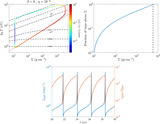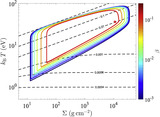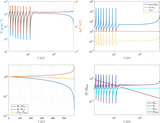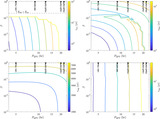Image Details
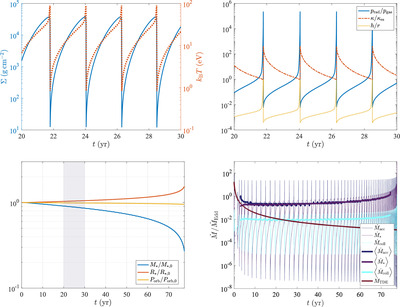
Caption: Figure 2.
Disk-star evolution for an initial Sun-like star (﹩{{ \mathcal M }}_{\star }={{ \mathcal R }}_{\star }=1﹩), neglecting collision/ablation heating (β = 0), for fiducial parameters (M • = 106 M ⊙, P QPE = 4 hr; η = 10−3; α = 0.1). Top left panel: surface density (solid blue) and midplane temperature (dotted red) as a function of time. Top right panel: p rad/p gas, κ/κ es, and h/r as a function of time. Gas pressure dominates over radiation pressure and opacity is dominated by Kramer’s throughout the “low” branch of the limit cycle. Bottom left panel: stellar and orbital properties as a function of time (M ⋆, R ⋆ , and P orb), from TDE to near depletion of the star. The change in P orb is calculated based on the impulse the star receives due to the mass swept up by disk collisions. As expected for these parameters, the stellar ablation rate greatly exceeds the rate of orbital decay due to hydrodynamical drag. Bottom right panel: time evolution of instantaneous and cycle-averaged rates of accretion ﹩{\dot{M}}_{\mathrm{acc}}﹩, stellar mass stripping ﹩| {\dot{M}}_{\star }| ﹩ , and disk mass impacted by the star ﹩{\dot{M}}_{\mathrm{coll}}﹩, in comparison to the TDE fallback rate ﹩{\dot{M}}_{\mathrm{TDE}}.﹩
Copyright and Terms & Conditions
© 2024. The Author(s). Published by the American Astronomical Society.



